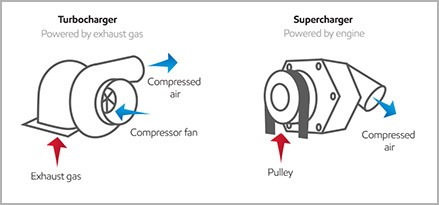All About Turbochargers
Table of ContentsGetting The Turbochargers To WorkWhat Does Turbochargers Mean?Some Known Facts About Turbochargers.
Modern turbochargers can utilize wastegates, blow-off valves and variable geometry, as talked about in later sections. In gas engine turbocharger applications, boost pressure is limited to keep the entire engine system, consisting of the turbocharger, inside its thermal and mechanical design operating variety (turbochargers). Over-boosting an engine often causes damage to the engine in a range of ways including pre-ignition, getting too hot, and over-stressing the engine's internal hardware.Opening the wastegate permits the excess energy predestined for the turbine to bypass it and pass straight to the exhaust pipeline, hence minimizing boost pressure. The wastegate can be either managed by hand (often seen in airplane) or by an actuator (in vehicle applications, it is typically controlled by the engine control system).

The increased temperature level from the higher pressure provides a higher Carnot effectiveness. A minimized density of consumption air is brought on by the loss of atmospheric density seen with elevated altitudes. Thus, a natural use of the turbocharger is with aircraft engines. As an airplane climbs up to greater altitudes, the pressure of the surrounding air rapidly falls off.
In aircraft engines, turbocharging is frequently used to preserve manifold pressure as altitude increases (i. e. to compensate for lower-density air at higher altitudes). Considering that atmospheric pressure lowers as the airplane climbs, power drops as a function of altitude in normally aspirated engines. Systems that use a turbocharger to maintain an engine's sea-level power output are called turbo-normalized systems.

5 inHg (100 kPa). Turbocharger lag (turbo lag) is the time needed to change power output in response to a throttle modification, observed as a hesitation or slowed when speeding up as compared to a naturally aspirated engine. This is due to the time required for the exhaust system and turbocharger to create the required boost which can also be described as spooling.
About Turbochargers
Superchargers do not suffer this problem, because the turbine is removed due to the compressor being directly powered by the engine. Turbocharger applications can be categorized into those that need modifications in output power (such as automotive) and those that do not (such as marine, airplane, business vehicle, commercial, engine-generators, and locomotives).
Engine creates lower lag in a variety of ways: Lowering the rotational inertia of the turbocharger by using lower radius parts and ceramic and other lighter products Altering the turbine's a fantastic read aspect ratio Increasing upper-deck atmospheric pressure (compressor discharge) and enhancing wastegate reaction Lowering bearing frictional losses, e. g., using a foil bearing instead of a standard oil bearing Utilizing variable-nozzle or twin-scroll turbochargers Reducing the volume of the upper-deck piping Utilizing numerous turbochargers sequentially or in parallel Using an antilag system Using a turbocharger spindle valve to increase exhaust gas circulation speed to the (twin-scroll) turbine In some cases turbo lag is misinterpreted for engine speeds that are listed below boost limit.
This wait for car speed boost is not turbo lag, it is improper gear selection for increase need. turbochargers. When the automobile reaches sufficient speed to supply the needed rpm to reach boost threshold, there will be a far much shorter hold-up while the turbo itself builds rotational energy and shifts to positive increase, just this last part of the hold-up in achieving favorable boost is the turbo lag.
Below a specific rate of circulation, a compressor produces irrelevant increase. This limits increase at a specific RPM, regardless of exhaust gas pressure. More recent turbocharger and engine developments have gradually decreased boost limits. Electrical enhancing (" E-boosting") is a new technology under development. It uses an electrical motor to bring the turbocharger as much as running speed quicker than possible utilizing available exhaust gases.

The running speed (rpm) at which there suffices exhaust gas momentum to compress the air going into the engine is called the "increase threshold rpm". Reducing the "boost limit rpm" can improve throttle action - turbochargers. The turbocharger has three main components: The turbine, which is practically constantly a radial inflow turbine (but is usually a single-stage axial inflow turbine in big Diesel engines) The compressor, which is practically always a centrifugal compressor The center housing/hub rotating assembly Lots of turbocharger setups use additional innovations, such as wastegates, intercooling and blow-off valves.
The 15-Second Trick For Turbochargers
On the right are the braided oil supply line and water coolant line connections. Compressor impeller side with the cover eliminated. Turbine side real estate eliminated. Energy review provided for the turbine work is transformed from the enthalpy and kinetic energy of the gas. The turbine housings direct the gas flow through the turbine as it spins at as much as 250,000 rpm.
Typically the very same fundamental turbocharger assembly click now is offered from the producer with multiple housing options for the turbine, and in some cases the compressor cover too. This lets the balance in between efficiency, reaction, and efficiency be customized to the application. The turbine and impeller wheel sizes also dictate the quantity of air or exhaust that can stream through the system, and the relative performance at which they operate.
Measurements and shapes can vary, as well as curvature and number of blades on the wheels. A turbocharger's performance is closely connected to its size. Big turbochargers take more heat and pressure to spin the turbine, producing lag at low speed. Little turbochargers spin quickly, but may not have the exact same efficiency at high velocity.